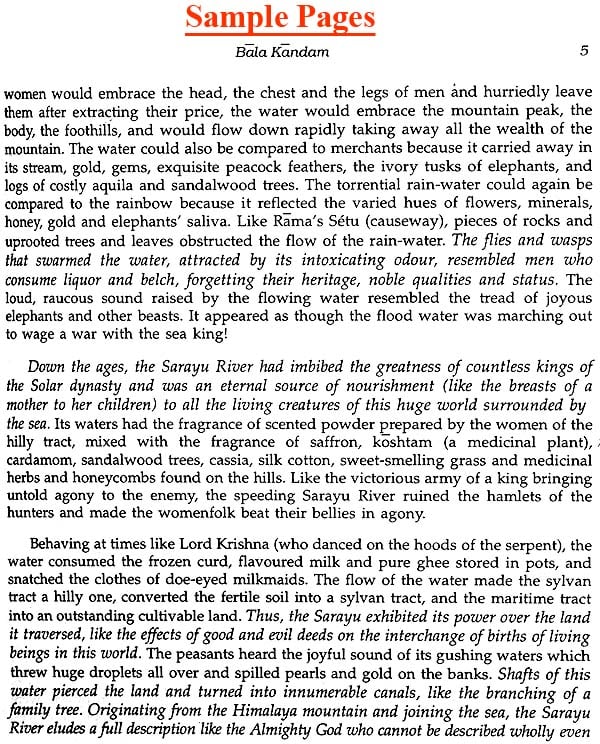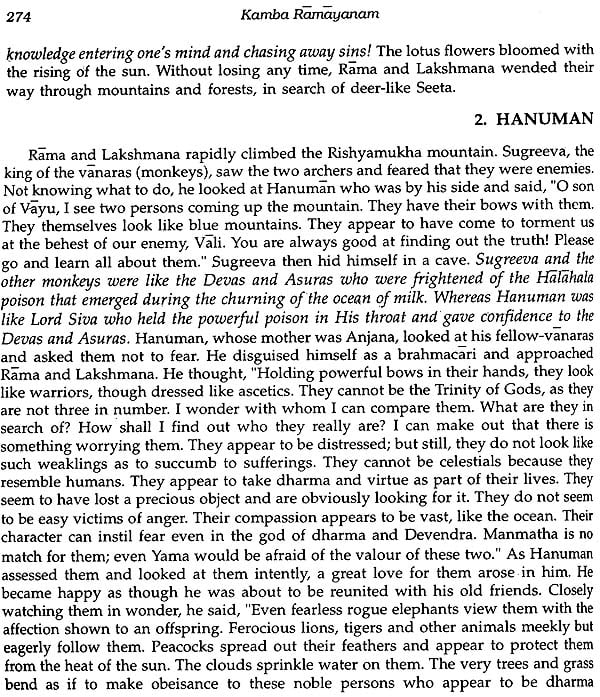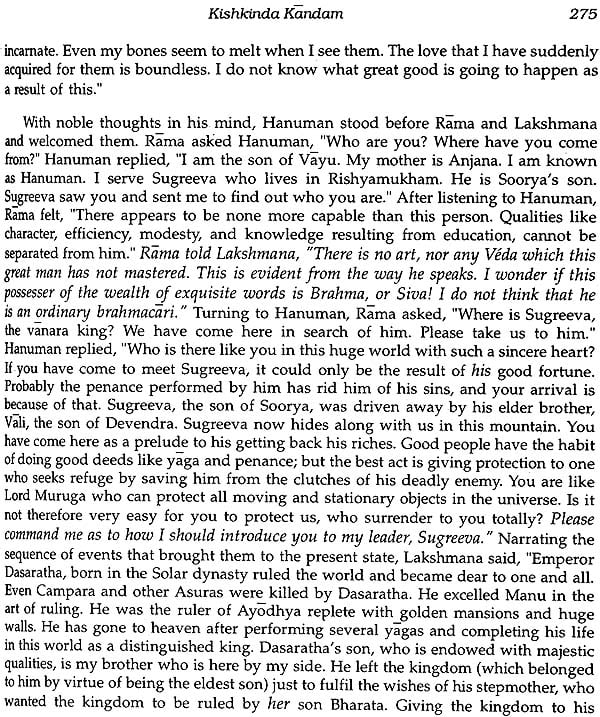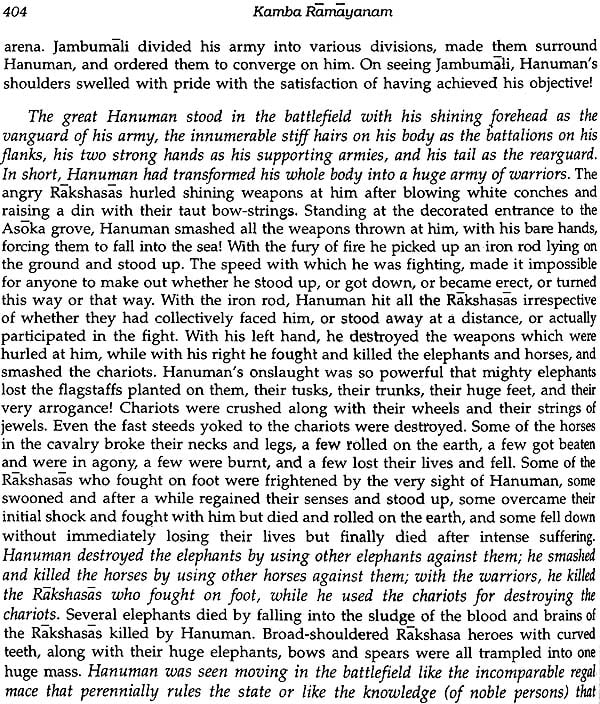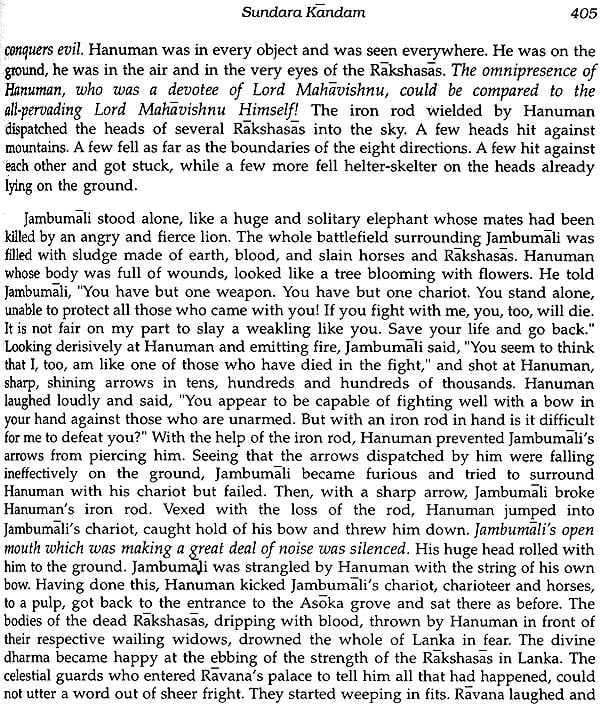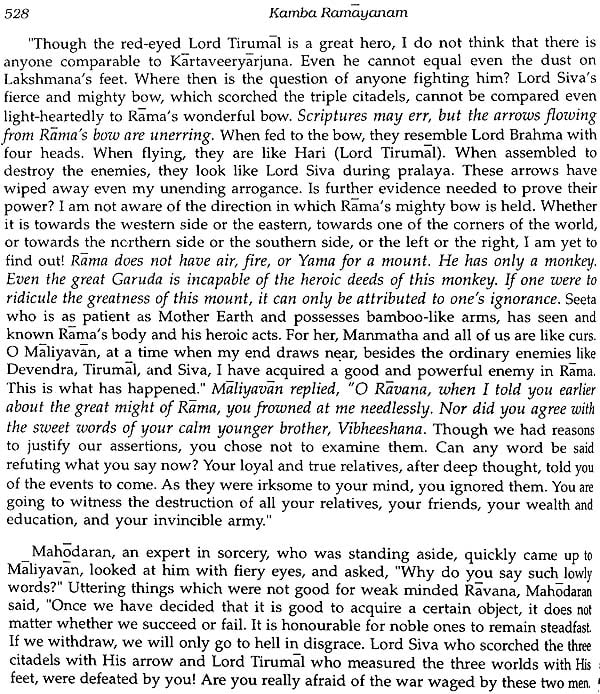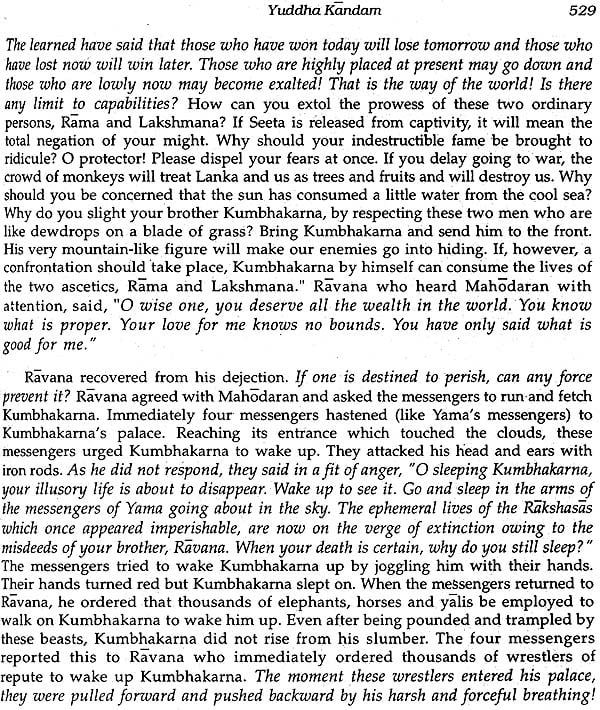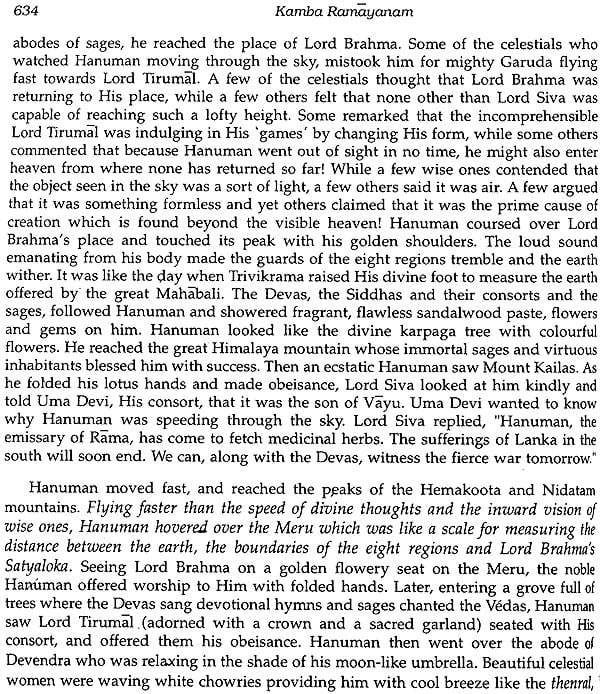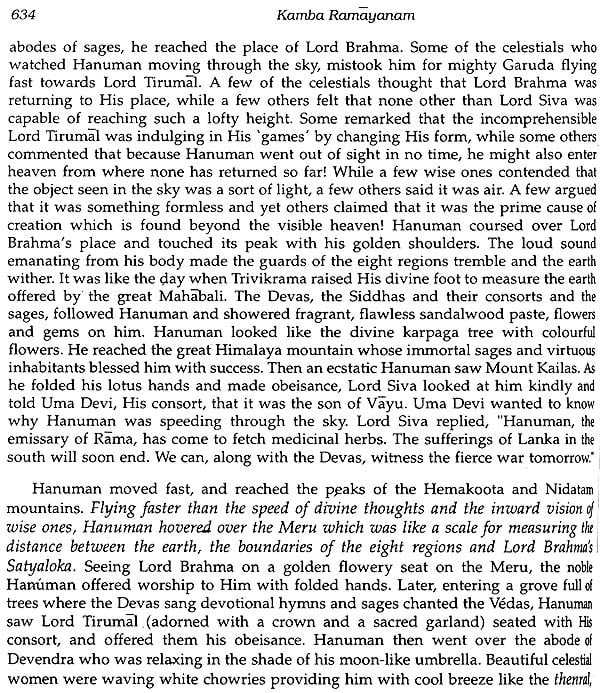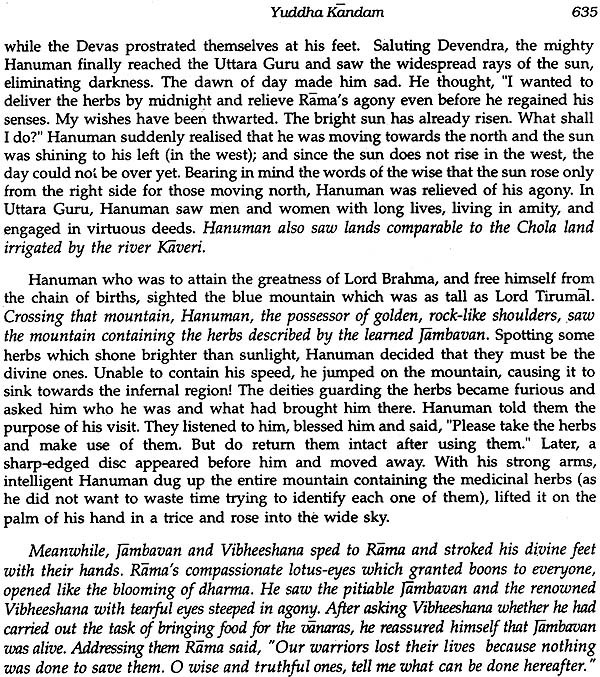
Kamba Ramayanam - An English Prose Rendering (An Old and Rare Book)
Book Specification
| Item Code: | NAN838 |
| Author: | Dr. H. V. Hande |
| Publisher: | Bharatiya Vidya Bhavan |
| Language: | English |
| Edition: | 1996 |
| Pages: | 809 |
| Cover: | Hardcover |
| Other Details | 9.5 inch X 7.5 inch |
| Weight | 1.50 kg |
Book Description
The RAMAYANA is not a mere 'story' nor is it a mere 'epic poem'. Sri Rama is both God and man. As Mahayogi Sri Aurobindo has declared, "The RAMAYANA is at once history, legend and a poem unmatchably sublime, supremely artistic and magnificently dramatic."
Valmeeki, the adikavi, has inspired the poets of this sacred land to retell Rama's glorious life in their respective tongues. Kavicakravarti Kamban's Ramavataram, Rama's story in six books, is both a landmark in the history of Tamil literature and an exemplary literary masterpiece. There are few lovers of Tamil who have not been entranced by its beauty of expression, richness of imagery and ethical grandeur. Shri V V Slyer, the great revolutionary patriot, would claim for Kamban's Ramavataram an 'individuality' distinct from Valmeeki's. He confidently asserts that Kamban's Ramavataram will stand favourable comparison with the Mahabharata, too. He also avers that it excels Homer's celebrated Iliad, Virgil's Aeneid and Milton's Paradise Lost.
Dr H V Hande, by providing us with this superb English prose rendering of Kamban's Tamil classic, has done the nation a great service.
Kamban was born in the ninth century in Therazhundur, a village in Thanjavur district. The greatest of the poets who wrote in Tamil and enriched its literature, Kamban hailed from a family which had Lord Narasimha (who emerged from a Kamba or pillar) as its family deity. Kamban was also called Kamba Nattazhwar, as he revived the greatness of Tamil through his work Kamba RAMAYANAm. Some believe that because he tied to himself the elephant known as Rama with the rope of his devotion, he resembled a pillar (Kamba). and therefore came to be known as Kamban. A few believe that he was so named because, as an infant, he was found lying near the pillar of a temple. Kamban's narration of the incarnation of Lord Tirumal (Mahavishnu) as Rama. is not a translation of Valmeeki's RAMAYANA, but an original retelling of the story of Rama.
Kamban was a great scholar in Tamil as well as Sanskrit. Extolled as Kavicakravarti (the emperor of poets), he rendered the RAMAYANA into nectarous verses in Tamil. He had the grace of Lord Narasimha and Kali Devi. Legend has it that Kali Devi used to hold a lamp to light the place, while he wrote the RAMAYANAm. Saraswati, the goddess of learning, is believed to have sat before him, apprising him each day of the approach of dawn as he was too engrossed in writing to notice anything.
Great poets have observed that even a life of unbounded happiness in this world or in heaven would not give the pleasure equal to that obtained by reading Kamba RAMAYANAm.
Salutations and adorations to Adikavi Valmeeki, Kavicakravarti Kamban (9th century), Sant Sahitya Shiropatra Tulasidas (16th century) and the grand, endless procession of poet-saints of Mother India!
"Dharma (Aram) leads to well-being here and hereafter," declared an ancient sage. This for the individual. When it comes to a nation, too, it is dharma that holds it together. No one can deny that for both, individual and national welfare, people at all levels should adhere to dharma or right conduct, a concept which springs from the very Vedas. However, our compassionate sages realised that dharma, as propounded in the Vedas, was too abstruse for laymen to comprehend and practise. So they created works in which the main characters exemplified dharma. Sage Valmeeki's epic poem, RAMAYANA, is one such great work. Presented in a delectable literary form, his Sanskrit epic of 24,000 verses is a practical guide to dharma. It also delineates the consequences of following dharma, and of transgressing it. Hence reading it and listening to discourses on it, are a means to learning the lessons of right conduct. More than any law - there is a well-known saying that we cannot legislate a people into morality- it is this epic that has shaped the ethos of a large majority of Indians. Therefore any effort to revive the study of the epic, is a positive measure towards strengthening the moral fibre of the nation. For this important reason Dr H V Hande's English prose rendering of Kamban's RAMAYANAm for those who do not know Tamil, deserves all praise.
Sage Valmeeki, in his quest for the ideal protagonist, goes to the omniscient sage, Narada. Narada gives him a short account of the story of Rama. The hero has to be human; or else of what use will the standards he sets for himself be to the common man? Rama himself says in the RAMAYANA, "I consider myself to be a human being." Valmeeki performs the miracle of casting the Infinite in the role of the finite, of squeezing the Timeless into the time-frame. Rama, the hero of the epic, is an incarnation of God, but he remains human at all times. He weeps, he worries, is often bewildered. Thus, suffering sorrowing man finds it easy to identify with him.
It was compassion that brought Rama down to earth and therefore his story, RAMAYANA, too, had to sprout from the seed of compassion. How did this happen? Soon after hearing Narada's story of Rama in brief, Valmeeki finds a lovely spot to bathe in, the sparkling waters of the Tamasa River. With Rama's character in mind, he tells his disciple, "Look, revered Bharadwaja, the water is as limpid as a good man's mind." Even as the serene sage drinks in the scenic beauty, a mortally-wounded Krauncha bird, brought down by the arrow of a hunter, falls at his feet. Hovering around the dying, bleeding male bird, is his piteously shrieking mate who a moment ago was with her beloved. Compassion instantly wells up in the heart of the sage, and finds expression in the famous sloka "Maa Nishaada ... " "0 fowler, may you know no rest for endless years, since you killed one of this pair of Krauncha birds while it was under the spell of love." It was a perfect sloka born out of soka (sorrow). Yes. It was sorrow taking the form of a song, soka embodying itself in sloka. Using this sloka as a model, Valmeeki composed his RAMAYANA for all mankind to recite and transcend sorrow.
The RAMAYANA has been, is and will ever be, the living legacy of India because it unfolds the story of RAMA and SEETA who are purer than purity itself and whose scrupulous adherence to the majesty of the moral law, dharma, is an abiding example to be emulated by all who have higher aspirations. Rama has been venerated by millions, for thousands of years, age after age, as the highest of the high, the Ideal Man –Maryada Purushottama, the effulgent embodiment of dharma. And of Seeta, the paragon of virtue, grace, purity and beauty, Swami Vivekananda says, "You may exhaust the literature of the world that is past and I may assure you that you will have to exhaust the literature of the world of the future, before finding another Seeta. Seeta is unique; that character was depicted once and for all. There may have been several Ramas perhaps, but never more than one Seeta. Mark my words. Seeta has go.ne into the very vitals of our race."
Adikavya Valmeeki RAMAYANA is the first ever kavya in Sanskrit literature. Inspired by Valmeeki's adikavya, poet-saints from all over India have authored different versions of the epic in their respective tongues. We have Assamese, Bengali, Gujarati, Hindi, Kannada, Kashmiri, Manipuri, Malayalam, Odissi, Punjabi, Tamil, Telugu, and Sanskrit versions, too, to name a few (see page 753). All of these are more than mere translations. The mystic revolutionary and patriot, Shri V V S Aiyar, a contemporary of Mahayogi Sri Aurobindo, makes the following incisive observations in his Introduction to, the Bhavan's Book University series title, Kamba RAMAYANA - A Studu": "Indian poets even of the second rank have with unerring good sense abstained from translating the Sanskrit classics, but instead have re-written them in their own way for their countrymen. Thus while Europe has but one Iliad and one Aeneid and a host of translations of these epics, India has not one RAMAYANA and one Mahabharata but at least a score of RAMAYANAs and Mahabharatas." Among these the most well-known by far are the Ramacharitmanas of Tulasidas in Hindi and Kamban's RAMAYANAM in Tamil.
This is Shri V V S Aiyar's penetrating assessment of Kavicakravarti Kamban's wondrous Tamil work RAMAYANAM:
"When a mahakavya of an earlier poet is taken up for the theme of an epic by a later one, the influence of the original writer becomes a leaden weight and a shackle to the poet who attempts a 're-do' of it. But Kamban, while following Valmeeki, has the breadth and power of Adisesha who bears the entire weight of the world on his single head. The poetic atmosphere, the significant structure, the psychological frame, in short the entire weight of the poetic inspiration and mystic intuitions of Valmeeki, became handmaids to Kamban; and with his singular skill and sense of beauty, he makes Valmeeki's key ideas, key images
The RAMAYANA is not an epic of India alone but of the whole world. There is not a single country in which the RAMAYANA or at least some one or other of its aspects, traditions or morals, is not known. In any event, the whole of South East Asia is familiar with the RAMAYANA, even though there may be variations from country to country, in respect of one part of the story or the other, contained in the RAMAYANA. As far as India is concerned, the RAMAYANA took its birth from Valmiki in Sanskrit; and the story caught the imagination and fascination of the people to such an extent that some part of it or other found a place either independently or as part of some other work that originated from the country. It has spread to other parts of South East Asia as a result of the people of India going to these parts along with the said story, in as much as the same was ingrained in their lives themselves and therefore took root there with variations in the details of the story here and there.
The first author of this great epic is Valmiki in Sanskrit and the other two well-known versions are by Kamban in Tamil and Tulasidas in Hindi. The present book is concerned with Kamban's version of the epic referred to as Kamban's Ramavataram or Kamban's RAMAYANAm. There has been, from the time point of view, a long interval between Valmiki and Kamban and admittedly Kamban has taken the story from Valmiki. However, Kamban proved to be a greater artist as a poet, in his version of RAMAYANA. In fact, Kamban is admitted to be the greatest epic poet in Tamil because of this creation of his.
Shri V V S Aiyar has pointed out in his 'Kamba RAMAYANA - A Study', a Delhi Tamil Sangam publication: "It is not easy to convince the literary world at this late hour of day that there is, unsuspected by the greater part of it, a Tamil poet who is worthy to take rank with the greatest names in literature. It is, however, my purpose in this book to make an attempt to prove that in the RAMA YANA OF KAMBAN the world possesses an epic which can challenge comparison not merely with the Iliad and the Aeneid, Paradise Lost and the Mahabharata, but with its original itself, namely, the RAMAYANA of Valmiki. This is not the language of mere patriotic enthusiam. It is an opinion that has grown slowly with the years and after deep and careful study. And I hope to make the impartial reader rise from the study of this monograph with a conviction of the truth of my contention and with a desire to know more of the poet than what he will see exhibited within the pages of this volume."
Similarly, in his Foreword to KAMBAN by the late Justice S Maharajan published by Sahitya Akademi, New Delhi, Professor Edward Leuders, Department of English, University of Utah, Salt Lake City, Utah, USA, observes: "It is clear to me even from a cursory reading of these excerpts that the translator is working with both a poet and an epic poem of high calibre indeed. The characteristic reach of the poet, Kamban, for cosmic personification in his poetry clearly ties these high and abstract matters to very human detail. It is the world of human experience he deals with, and it is through the exaltation of poetic 'song that he achieves what all the world's great poetry attempts to achieve - a marriage of the divine and timeless with the earthly and experiential".
Such is the work of Kamban in his RAMAYANAm that to everyone who is familiar with the work, he is Kavicakravarti (emperor of poets). The fact that Kamban was able to write his epic in more than 10,000 verses of four lines each with astonishing nuances of poetry and at the same time conforming to the known classification of verses in Tamil language, is something not only to be admired but also to be wondered at. It is in view of these features of Kamban's art, admirably displayed in his Ramavataram, his name and fame have become matchless and unrivalled and the word, 'Kavicakravarti ' has come to refer only to Kamban, and if anybody else wants to admire or eulogise any other poet as an eminent one, the word, Kavicakravarti is added before his name in an adjectival form.
It is this epic of Kamban that has been rendered into English by Dr H V Hande. Once the question of translating the grand poetry of Kamban into another language arises, the point that immediately comes to mind is whether the translation should also be in poetic form or it can be in prose. There is no gainsaying the fact, whether the translation is in the form of verse or in prose, that it is impossible to bring out the beauty, grandeur, majesty and the easy flow of the original of the Master Artist and that too when what the Master Artist has written is something inimitable in style, and selection of words appropriate to the character and the event. In this case, all those who have had occasion to read Kamban to any extent, would have been completely taken in by and absorbed in the genius and the originality displayed. In such a context it is unthinkable that anyone can succeed in translating Kamban's Ramavataram into English in verse form.
As a matter of fact, Rajaji, one of the greatest men of our times with profound knowledge of almost every aspect of human life and in whose case, every word that he uttered and every word that he wrote has proved to be profound and prophetic, has translated in English i!1 verse form the Ayodhya Kandam of Kamban's RAMAYANA, published by Sahitya Academy in accordance with an agreement between UNESCO and the Government of India, in furtherance of UNESCO's aim to promote mutual appreciation of the cultural values of East and West, and he has the following to say in his preface: "Kamban sang the story of Rama as of God come down on earth to suffer, chasten, uplift, help and guide men. Apart from this difference in the treatment of the hero, there is considerable difference in poetic form between Valmiki and Kamban. Kamban's RAMAYANA is a lyric, while Valmiki's is an epic. The lyric is a string of cut gems with glittering facets sparkling at each turn. It is not a solemn march of predestined sadness like Valmiki's epic. The lyric sparkle of Kamban and Tulasidas goes well with their constant reminder that Rama is the Supreme Being Himself.
"The unique characteristic of Tamil verse is the initial rhyme. In good Tamil poetry, unlike the end-rhyme in English or Hindustani, it is not just a purposeless jingle that has become a custom. The initial rhyme in Tamil is a medium of emphasis and climax
It was with a great deal of nervous hesitation and humility that I ventured to render Kamban's Ramavataram, an epic of 10000-odd, 4-line stanzas, into English prose. I was inspired to attempt this, over eight years ago, after reading a couple of English translations of Valmeeki's RAMAYANA.
My effort is not a verbatim translation of the work of Kamban, the emperor of Tamil poets, but only a free rendering in English. In fact, I have abridged five chapters of BALA KANDAM which describe the march of Dasaratha's entourage from Ayodhya to Mithila and also a few portions of YUDDHA KANDAM.
After delving deep into Kamban's work, I am convinced that exposure to it, is a must for every lover of Truth and literature, irrespective of his or her creed or nationality. Vice and virtue, filial duty, fraternal love, loyalty, friendship, marital fidelity and more, have been splendidly dealt with by the poet in his eternally relevant divine masterpiece.
Kambans poetic genius lies in his brilliant use of rhyme, alliteration, simile and epithet; all of which he skilfully blends, making a recitation of his work an audio-visual treat. So musical are the words and so vivid the imagery! While it is impossible to reflect the poetry of such an original in a prose translation, especially into English, I have tried my best to do justice to his unique similes and apt epithets. I have even resorted to archaic words or usages, at times, to this end.
Wherever I have wanted the reader to pause and internalise a concept, or a sentiment, I have italicised the text. If the reader derives as much from this book, as I did from writing it, I would consider my labour of love amply rewarded.
With boundless pleasure I dedicate this book to the people of Tamil Nadu who have showered their love on me so profusely all these years.
| BALA KANDAM | ||
| KAMBA 'S PREFACE | 3 | |
| 1 | THE RIVER | 4 |
| 2 | THE COUNTRY | 6 |
| 3 | THE CITY OF AYODHYA | 12 |
| 4 | EMPEROR DASARATHA | 18 |
| 5 | I CARNATION | 20 |
| 6 | HA DI G OVER RAMA AND LAKSHMANA | 29 |
| 7 | THE SLAYIN G OF TATAKAI | 30 |
| 8 | THE YAGA | 34 |
| 9 | AHALYA | 39 |
| 10 | THE CITY OF MITHILA | 41 |
| 11 | RAMA'S ANCESTRY | 50 |
| 12 | THE BOW | 53 |
| 13 | DASARATHA LEAVES FOR MITHILA | 59 |
| 14 | CHANDRASAILA | 65 |
| 15 | THE MOUNTAIN | 66 |
| 16 | PLUCKI G FLOWERS | 68 |
| 17 | SPORTI G IN THE WATERS | 70 |
| 1 . | FESTIVITY | 71 |
| 19 | WELCOMING DASARATHA | 73 |
| 20 | THE PROCESSION | 76 |
| 21 | THE GRACEFUL SEETA | 79 |
| 22 | THE WEDDING | 84 |
| 23 | PARASURAMA | 92 |
| AYODHYA KANDAM | ||
| 1 | DASARATHA COFERS WITH HIS MINISTERS | 99 |
| 2 | MA TARAI'S MACHI ATIONS | 105 |
| 3 | THE EVIL DESIGNS OF KAIKEYI | 111 |
| 4 | LEAVING THE CITY | 121 |
| 5 | DASARATHA'S BODY EMBALMED | 140 |
| 6 | MOTHER GANGA | 147 |
| 7 | GUHAN | 149 |
| 8 | ENTERING THE FOREST | 153 |
| 9 | CITRAKOOTAM | 156 |
| 10 | DASARATHA CREMATED | 160 |
| 11 | ONWARD JOURNEY | 170 |
| 12 | CROSSING THE GANGA | 175 |
| 13 | THE CORONATION OF RAMA'S SANDALS | 180 |
| ARANYA KANDAM | ||
| 1 | THE KILLING OF VIRADHA | 193 |
| 2 | SAGE SARABHANGA | 196 |
| 3 | SAGE AGASTYA | 199 |
| 4 | JATAYU | 202 |
| 5 | SOORPANAKHA | 205 |
| 6 | THE SLAYING OF KHARA | 214 |
| 7 | SOORPANAKHA'S EVIL DESIGNS | 224 |
| 8 | MARICA SLAIN | 235 |
| 9 | RAVANA'S TREACHERY | 242 |
| 10 | JATAYU'S DEATH | 248 |
| 11 | AYOMUKHI | 258 |
| 12 | KAVANDHA | 264 |
| 13 | SABARI | 268 |
| KISHKINDA KANDAM | ||
| 1 | LAKE PAMPAI | 271 |
| 2 | HANUMAN | 274 |
| 3 | SEEKING SUGREEVA'S FRIENDSHIP | 276 |
| 4 | THE SEVEN TREES | 282 |
| 5 | DUNDUBHI | 283 |
| 6 | THE SIGHT OF SEETA'S JEWELS | 284 |
| 7 | THE SLAYING OF VAlI | 286 |
| 8 | STATECRAFT | 300 |
| 9 | THE RAINY SEASON | 302 |
| 10 | KISHKINDA | 311 |
| 11 | VIEWING THE VANARA ARMY | 321 |
| 12 | THE SEARCH | 323 |
| 13 | ENTERING A CAVERN | 328 |
| 14 | ONWARD JOURNEY | 332 |
| 15 | SAMPATI | 334 |
| 16 | THE MAHENDRA MOUNTAIN | 338 |
| SUNDARA KANDAM | ||
| l. | CROSSING THE SEA | 343 |
| 2 | HANUMAN EXPLORES LANKA | 349 |
| 3 | SEETA SEEN | 366 |
| 4 | RA VA A CHASTISED | 372 |
| 5 | HA UMAN REVEALS HIMSELF | 379 |
| 6 | CHOODAMANI | 388 |
| 7 | THE DESTRUCTION OF THE ASOKA GROVE | 394 |
| 8 | THE SLAYING OF THE KINKARAS | 398 |
| 9 | THE SLAYING OF JAMBUMALI | 402 |
| 10 | THE SLAYING OF THE FIVE CHIEFS | 406 |
| 11 | THE SLAYING OF AKSHAKUMARAN | 410 |
| 12 | HANUMAN BOUND | 414 |
| 13 | THE SEVERING OF THE ROPES | 417 |
| 14 | THE BURNING OF LANKA | 426 |
| 15 | WORSHIPPING THE SACRED FEET | 430 |
| YUDDHA KANDAM | ||
| l. | THE SIGHT OF THE SEA | 437 |
| 2 | RAVA A CONFERS WITH HIS MINISTERS | 438 |
| 3 | THE SLAYING OF HIRAYAN | 446 |
| 4 | VIBHEESHANA TAKES REFUGE | 461 |
| 5 | INFORMATIO | 473 |
| 6 | SEEKI G PASSAGE FROM VARUNA | 479 |
| 7 | BUILDING THE SETU | 485 |
| 8 | QUESTIONING THE SPIES | 489 |
| 9 | SEEING LANKA | 495 |
| 10 | RAVA A VIEWS THE VANARA ARMY | 497 |
| 11 | TOPPLING THE CROWNS | 499 |
| 12 | BATTLE LINES DRAWN | 503 |
| 13 | ANGADA AS ENVOY | 506 |
| 14 | THE FIRST DAY'S FIGHT | 509 |
| 15 | KUMBHAKARNA | 526 |
| 16 | THE MAYA JANAKA | 553 |
| 17 | THE SLAYING OF ATIKAYA | 561 |
| 18 | THE SERPENT NOOSE | 579 |
| 19 | THE SLAYING OF THE ARMY COMMA DERS | 603 |
| 20 | THE SLAYING OF MAKARAKA | 609 |
| 21 | BRAHMASTRAM | 612 |
| 22 | SEETA SEES THE BATTLEFIELD | 628 |
| 23 | MOUNTAIN OF MEDICINAL HERBS | 631 |
| 24 | JUBILATION | 639 |
| 25 | MAYA SEETA | 640 |
| 26 | YAGA AT NIKUMBALAI | 647 |
| 27 | THE SLAYING OF INDRAJIT | 661 |
| 28 | RAVANA'S GRIEF | 667 |
| 29 | SURVEYING THE ARMY | 671 |
| 30 | THE DESTRUCTION OF THE CORE ARMY | 676 |
| 31 | A VEL BORNE | 690 |
| 32 | THE VANARAS SEE THE FRONT | 694 |
| 33 | RAVANA VISITS THE FROT | 696 |
| 34 | RAVANA BOARDS HIS CHARIOT | 698 |
| 35 | RAMA BOARDS THE CHARIOT | 700 |
| 36 | The SLAYING OF RAVANA | 702 |
| 37 | LIBERATION AND RETURN | 719 |
| 38 | THE CORONATION | 745 |
| 39 | BIDDING FAREWELL | 749 |
| THE RAMAYANA IN INDIAN LANGUAGES | 753 | |
| THE RAMAYANA I OTHER ASIAN LA GUAGES | 757 | |
| THE RAMAYANA IN ENGLISH | 758 | |
| (Bharatiya Vidya Bhavan Publications) | ||
| LIST OF RAMAYANA-RELATED STUDIES | 760 | |
| (Published in India) | ||
| SUBJECT IDEX | 773 |
